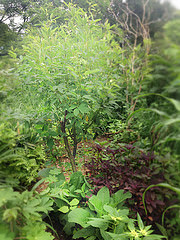In my last post I talked about observing the systems around us to get an idea as to why making space for mulch-producing plants is so important. In this post I’ll start introducing the plants we use to create such a guild.
The Pigeon Pea (Cajuns radicans) serves as a support for climbing beans while its small canopy cools the ground around it with filtered shade. The leaves are purportedly high in protein, perfect for encouraging the soil improving benefits of an increased worm population.
The Pigeon Pea that I’ve been using here are three years old. They seem to suffer from branch dieback most likely from drought stress at the end of the dry season, so I give them a good hacking to set off healthy leaf buds, if I’m not planning on growing a climbing plant up their bases.
The foliage flushes out again quickly, even more so when encouraged by regular hydrological activity. I strip the downed branches, return the foliage to the ground and save the stems and twigs for firewood and garden stakes.
At the base of the Pigeon Pea are third generation ‘Rattlesnake’ pole beans. These beans have begun climbing the Pigeon Pea, and will ideally fill in the bare stems left by an extended dry season. They have an extensively deep root system (up to two meters) that will decompose in place once the plants are slashed, providing a long-term source of nutrients for future plantings. While the foliage will be saved for mulching because of its high-protein content (again, for the worms), we’ll harvest the beans at maturity. The foliage can also be saved as food for our chickens.
Start thinking about plants with similar attributes for your guild. A small, fast growing tree with multiple functions is a great place to begin the process.



